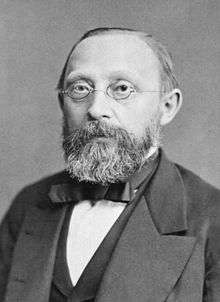
Virchow (crater)
Virchow is a small lunar impact crater that is located on the northwestern interior floor of the prominent crater Neper. The latter formation lies near the eastern limb of the Moon, along the southern edge of the Mare Marginis. Observation of this area is hindered due to foreshortening, as well as libration effects. Before being given a name by the IAU, this crater had the designation Neper G.
Virchow has a distorted shape, with a somewhat polygonal rim, particularly in the northern half. The northwestern rim protrudes outwards, giving the crater an asymmetrical appearance. This section of the rim just makes contact with the inner wall of Neper crater. The inner walls of Virchow are relatively narrow, and the interior floor is nearly level and almost featureless.
References
External links
Crater
Crater may refer to:
In landforms:
Other:

Crater (Aden)
Crater (/ˈkreɪtər/; Arabic: كريتر, [ˈkɾeːtəɾ]), also Kraytar, is a district of the Aden Governorate, Yemen. Its official name is Seera (Arabic: صيرة Ṣīrah). It is situated in a crater of an ancient volcano which forms the Shamsan Mountains. In 1991, the population was 70,319. As of 2003, the district had a population of 76,723 people.
In the closing days of British rule in 1967, Crater District became the focus of the Aden Emergency, sometimes called the last imperial war. After a mutiny of hundreds of soldiers in the South Arabian Federation Army on 20 June, all British forces withdrew from the Crater. The Crater was occupied by Arab fighters while British forces blocked off its two main entrances. In July, a British infantry battalion, led by Lt. Col. Colin Mitchell of the Argyll & Sutherland Highlanders, entered the Crater and managed to occupy the entire district overnight with no casualties. Nevertheless, deadly guerrilla attacks soon resumed, with the British leaving Aden by the end of November 1967, earlier than had been planned by British Prime Minister Harold Wilson and without an agreement on the succeeding governance.
Crater (Chinese astronomy)
According to traditional Chinese uranography, the modern constellation Crater is located within the southern quadrant of the sky, which is symbolized as the Vermilion Bird of the South (南方朱雀, Nán Fāng Zhū Què).
The name of the western constellation in modern Chinese is 巨爵座 (jù jué zuò), meaning "the huge wine holder constellation".
Stars
The map of Chinese constellation in constellation Crater area consists of :
See also
References
External links

Rudolf Virchow
Rudolf Ludwig Carl Virchow (English /ˈvɪrkoʊ, ˈfɪrxoʊ/;German: [ˈvɪɐ̯çoː]; 13 October 1821 – 5 September 1902) was a German doctor, anthropologist, pathologist, prehistorian, biologist, writer, editor, and politician, known for his advancement of public health. He is known as "the father of modern pathology" because his work helped to discredit humourism, bringing more science to medicine. He is also known as the founder of social medicine and veterinary pathology, and to his colleagues, the "Pope of medicine".
Born and lived in Schievelbein (Świdwin) as an only child of a working-class family, he proved to be a brilliant student. Dissuaded by his weak voice, he abandoned his initial interest in theology and turned to medicine. With special military scholarship, he earned his medical degree from Friedrich-Wilhelms Institute (Humboldt University of Berlin) under the tutelage of Johannes Peter Müller. He worked at the Charité hospital under Robert Froriep, whom he eventually succeeded as the prosector.
Podcasts:

